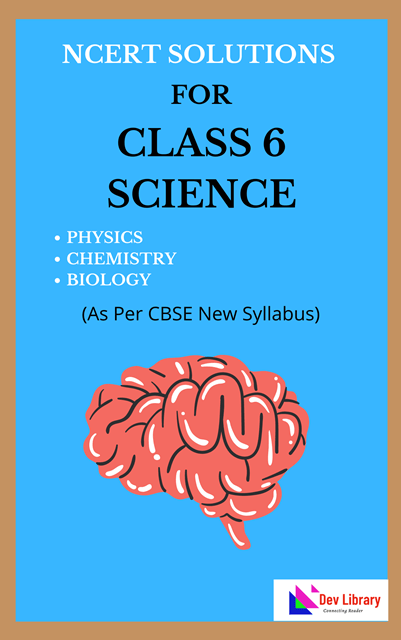NCERT Class 6 Science Chapter 3 Mindful Eating: A Path to a Healthy Body Solutions English Medium to each chapter is provided in the list so that you can easily browse through different chapters NCERT Class 6 Science Chapter 3 Mindful Eating: A Path to a Healthy Body Notes and select need one. NCERT Class 6 Science Chapter 3 Mindful Eating: A Path to a Healthy Body Question Answers Download PDF. NCERT Class 6 Solutions for Science English Medium.
NCERT Class 6 Science Chapter 3 Mindful Eating: A Path to a Healthy Body
Also, you can read the NCERT book online in these sections Solutions by Expert Teachers as per Central Board of Secondary Education (CBSE) Book guidelines. NCERT Class 6 Science Textual Solutions are part of All Subject Solutions. Here we have given NCERT Class 6 Science Chapter 3 Mindful Eating: A Path to a Healthy Body Notes English Medium. CBSE Class 6 Science in English Textbook Solutions for All Chapters, You can practice these here.
Mindful Eating: A Path to a Healthy Body
Chapter: 3
| Let us enhance our learning |
1. Pick the odd one out and give reasons:
(i) Jowar, Bajra, Ragi, Chana.
Ans: The odd one out is “Chana”. Jowar, Bajra, and Ragi are all types of millet crops, whereas Chana refers to chickpeas, which is a pulse crop.
(ii) Kidney beans, Green gram, Soya bean, Rice.
Ans: The odd one out is “Rice.” Kidney beans, green gram, and Soya bean are commonly used as protein sources while rice is a carbohydrate.
2. Discuss traditional versus modern culinary practices in India.
Ans: Traditional Practices:
(i) Cooking was mostly done on chulhas (traditional stoves).
(ii) Grinding was done manually using tools like sil-batta (stone grinder).
(iii) Emphasis on using fresh, locally grown ingredients.
Modern Practices:
(i) Use of modern gas stoves and electric appliances like grinders and mixers.
(ii) Availability and use of pre-packaged and processed foods.
(iii) Influence of global cuisines and fusion cooking.
3. A teacher says that good food may act as medicine. Ravi is curious about this statement and has some questions for his teacher. List at least two questions that he can ask.
Ans: (i) “How does good food act like medicine for our bodies?”
(ii) “Can you give examples of foods that are considered ‘medicine’?”
4. Not all delicious foods are necessarily healthy, while not all nutritious foods are always enjoyable. Share your thoughts along with a few examples.
Ans: Delicious food is not always healthy: Like, burgers, pizzas, chats, potato chips etc, are very tasty but not nutritious. These foods contain refined flour (Maida), spices and a lot of oil which is not good for health. On the other hand, nutritious food may not always be delicious to eat like, boiled vegetables, pulses, leafy vegetables etc., which are not always tasty but are very good for health. These foods contain important nutrients (proteins, vitamins, minerals etc.) which help us to maintain our body strong and healthy.
5. Medu does not eat vegetables but enjoys biscuits, noodles and white bread. He often has stomach ache and constipation. What changes should he make in his diet to get rid of these problems? Explain your answer.
Ans: Medu should include whole grains, whole pulses, fresh fruits and vegetables in his diet to get rid of her problems. These food items contain roughage (dietary fiber) which is lacking in Medu’s diet.
Medu should avoid eating biscuits, noodles and white bread as they are made up of refined flour (Maida) which does not contain any roughage or fiber. Roughage prevents constipation.
6. Reshma had trouble seeing things in dim light. The doctor tested her eyesight and prescribed a particular vitamin supplement. He also advised her to include a few food items in her diet.
(i) Which deficiency disease is she suffering from?
Ans: Night Blindness.
(ii) Which food component may be lacking in her diet?
Ans: Vitamin A.
(iii) Suggest some food items that she should include in her diet to overcome this problem (any four).
Ans: Carrot, Fish Oil, Sweet Potatoes, Spanish.
7. You are provided the following:
(i) Canned fruit juice.
(ii) Fresh fruit juice.
(iii) Fresh fruit.
Which one would you prefer and why?
Ans: Fresh fruit: Fresh fruits contain fibre and more nutrients compared to juices which might have added sugars and preservatives.
8. Gourav got a fracture in his leg. His doctor aligned the bones and put on a plaster. The doctor also gave him calcium tablets. On the second visit, the doctor gave him Vitamin D syrup along with calcium tablets. Refer to Fig. 3.5 and answer the following questions:
(i) Why did the doctor give calcium tablets to Gourav?
Ans: The doctor gave calcium tablets to Gourav because calcium plays a crucial role in bone health and healing. When a bone is fractured, calcium is essential for the process of bone healing.
(ii) On the second visit, why did the doctor give Vitamin D syrup along with calcium tablets?
Ans: The doctor gave Vitamin D syrup along with calcium tablets on the second visit to Gourav because Vitamin D helps in calcium absorption.
(iii) What question arises in your mind about the choices made by the doctor in giving the medicines?
Ans: A question that may arise about the doctor’s decision is: “How long should Gourav continue taking both calcium tablets and Vitamin D syrup?”
9. Sugar is an example of carbohydrates. Sugar is tested with iodine solution but it does not change to blue-black colour. What can be a possible reason?
Ans: The reason sugar does not change to a blue-black color when tested with iodine is that iodine specifically reacts with starch, not with simple sugars. Iodine forms a blue-black complex with starch, indicating its presence, but since sugar does not contain starch, no color change occurs.
10. What do you think of Raman’s statement, “All starches are carbohydrates but not all carbohydrates are starches.’’ Describe the design of an activity to test your answer.
Ans: Raman’s statement means that while all starches are a type of carbohydrate, there are other carbohydrates that aren’t starches. To test this, gather samples like sugar, rice, and potatoes. Perform an iodine test by adding iodine solution to each sample. If the sample turns blue-black, it contains starch. Only starches will show this colour change, while other carbohydrates (like sugar) will not react the same way. This demonstrates that not all carbohydrates are starches.
11. While using iodine in the laboratory, a few drops of iodine fell on Mishti’s socks and a few fell on her teacher’s saree. The drops of iodine on the saree turned blue-black while the colour on the socks did not change. What can be a possible reason?
Ans: Iodine solution turned blue-black because the saree worn by Mishti’s teacher must have contained starch and starch turns blue-black when exposed to iodine solution. Saree must be made of cotton, which has starch. Mishti’s socks would have been free from starch, that’s why her socks did not change color.
12. Why are millets considered a healthy choice of food? Can eating just millets suffice for the nutritional requirements of the body? Discuss.
Ans: Millets are considered a healthy choice of food because they are highly nutritious grains rich in vitamins, minerals like iron and calcium, and dietary fibres. They help in maintaining normal body functions and contribute to a balanced diet. However, eating only millets cannot suffice for the nutritional requirements of the body as a balanced diet requires a variety of foods to provide all essential nutrients like proteins, fats, vitamins, and minerals.
13. You are given a sample of a solution. How would you check the possibility of it being an iodine solution?
Ans: To check if the sample of solution is iodine solution, following test can be performed:
Starch Test (Iodine Test):
Add a few drops of the solution to a small amount of starch solution or starch indicator paper. Iodine forms a deep blue-black complex with starch. If the solution contains iodine, the color change to blue-black indicates the presence of iodine.

Hi! my Name is Parimal Roy. I have completed my Bachelor’s degree in Philosophy (B.A.) from Silapathar General College. Currently, I am working as an HR Manager at Dev Library. It is a website that provides study materials for students from Class 3 to 12, including SCERT and NCERT notes. It also offers resources for BA, B.Com, B.Sc, and Computer Science, along with postgraduate notes. Besides study materials, the website has novels, eBooks, health and finance articles, biographies, quotes, and more.



